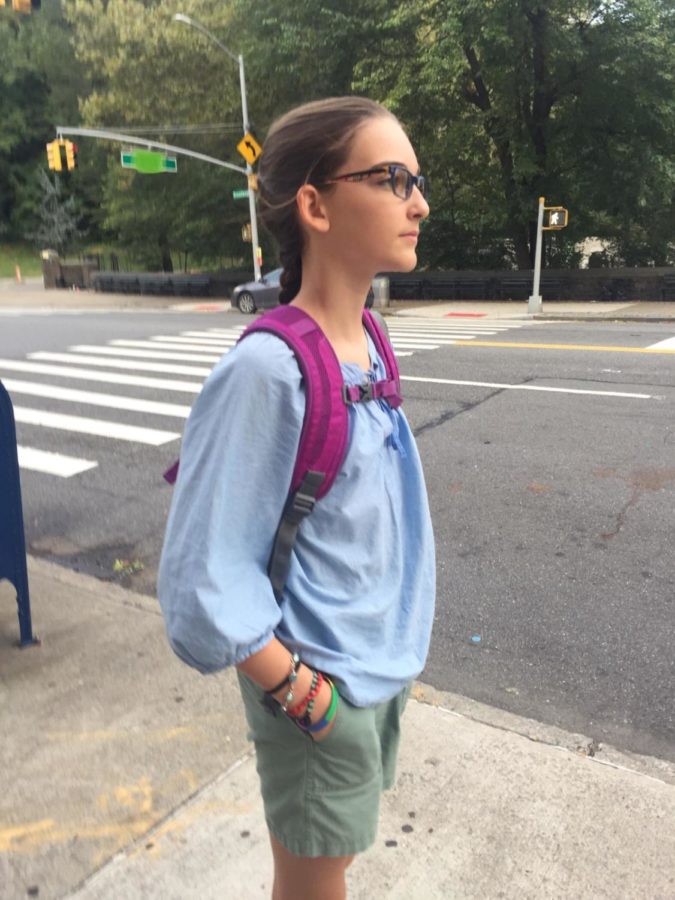The Risk of Walking: The Problem of ‘Street Harrassment’
Street harassment is rampant in New York City. However, why do harassers target kids?
A picture of me during the summer when I was first harassed when walking down a street in New York City. I was 12.
Street harassment is a unique evil. Getting harassed by men old enough to be your grandfather is perplexing and dismaying — it’s never completely clear why a complete stranger goes out of his way and chooses you to objectify. The first time you get harassed becomes one of the most life-altering moments in your life; it is burned into your memory. Your perception of who you are shifts permanently.
Immediately after, you’re left with a tangle of emotions — first and foremost being discomfort, followed often by panic and shame — and there is no easy way to rationalize these feelings. “I was honestly upset for a really long time,” said Arianne Browne ’22 about the first time that she was harassed verbally on the street in her neighborhood, at age 14. She elaborated “even now, walking around in the street — even around my own home — can feel disturbing. [It happens] no matter what I wear or how I look.”
As time goes on, the panic fades, but the shame lingers, usually in the form of blaming yourself. All of my interviewees described some feeling of shame stemming from being harassed from walking down the street in a public place in New York City. Several described what they were wearing when they were verbally assaulted the first time, as if what they had chosen to wear somehow “provoked” their harassers. “Every outfit that I have come up with, comes with a side note of whether or not I’ll be harassed on the street,” my friend Nat Zikova-English ’24, who attends High School of Art and Design, explains. “Sometimes it works; most of the time, it doesn’t.”
Why is the blame always on us?
The most important thing to remember after getting harassed with verbal comments while walking down the street, is this: it’s not your fault. It doesn’t have to do with how you were dressed, because street harassment happens no matter what you choose to wear. Harassment is all about power, and shame is simply a tool that harassers use to create an imbalance.
No one should ever experience sexual harassment. That’s a given. But what happens when 12, 13, and 14 year-olds are forced to endure adults making sexual comments about their bodies?
As Nat goes on to explain, “I’m not the strongest or most agile person alive, so walking alone feels like a gamble every time I go out.”
Street harassment is so abrupt that there’s no way to brace yourself. There’s no way to know how to effectively discourage it. In the best-case scenario, any given response results in getting left alone. The worst-case scenario is getting killed.
In my neighborhood, along the four-block stretch that it takes me to walk home from the subway after school, I can pick out five distinct places where a male-presenting adult has said something unsettlingly sexual to me as I walked home with my backpack on. Every single time, I’ve been filled with disgust and dread, because I know it’s going to happen again and I won’t be able to prevent it.
How, then, can we protect ourselves when doing the most benign thing in the world, walking? Why is going outside something that female-presenting teens and preteens have to plan for?
I’ve had conversations about the mental preparation that it takes to go outside. After all, that’s the only alternative to being caught unaware. When harassment is so common, preparing for it is the only thing that reduces the mental tension in the moment and after. My own preparations always involve having a friend on speed dial and making sure I have my noisemaker with me. When I feel capable of responding, I’ll rehearse some go-to responses (my favorite is “I’m 15”) and practice assessing the situation (only respond if there are other people around, and if the harasser is alone) before leaving my apartment.
Of course, if you’ve been harassed and told anyone about it, you’ve probably heard the formulaic phrase, “just ignore it.” Trying to ignore it and walk on is a viable option — the easiest option in the moment, usually, but it’s also the response that leaves you feeling the most powerless in an already unbalanced situation, and there’s truly no way to say whether that’s what will keep you the safest.
There’s no way to know how long street harassment has had a foothold in New York City and no foreseeable way to stop it. Since 2010, specific forms of verbal harassment have been outlawed in New York State, but it is close to impossible to enforce any of the proposed penalties. It is far from logical to report someone who can simply turn a corner and be gone in a minute; even if the harasser decided to stick around, there would be no way to prove that he said or did anything to harass you.
Walking should not be so scary.
Harassment is all about power, and shame is simply a tool that harassers use to create an imbalance.
Felicia Jennings-Brown is a Copy Chief for ‘The Science Survey.’ What she appreciates the most about journalistic writing is its use as a channel to...











